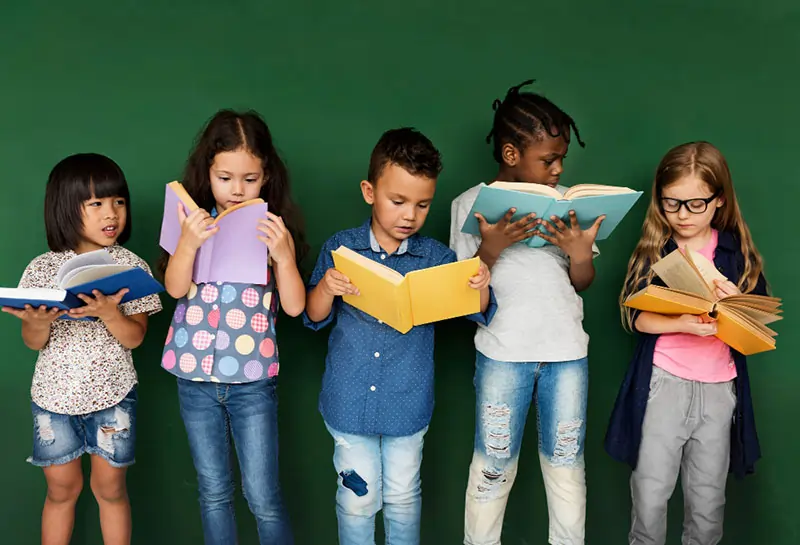Raising A Curious Reader: Nurturing A Love For Books

Cultivating a love for books in children not only provides enjoyment but also supports their overall growth. A curious reader is one who seeks to explore new worlds, ideas, and concepts through the pages of books, driven by an insatiable thirst for knowledge and understanding. But how can this be effectively achieved, especially when each child’s developmental pace varies?
Each child has unique characteristics. As such, the time and effort it takes to instill an interest in reading may vary. Several established methods can help children develop a strong interest in reading. This article serves as a valuable resource for parents, educators, and caregivers aiming to nurture young, curious readers.
Benefits Of Reading For Children
Reading clearly enriches a child’s mind, enhancing various skills necessary for their overall development. Here are the primary benefits your child could gain from having a love for books:
1. Listening Skills
Reading helps children develop listening skills. As they attentively follow along with the narrative, they’re entertained and learning to process and comprehend auditory information. These refined skills benefit children in classroom settings and everyday communication. It’s one reason preschool programs include storytime, as it harnesses these benefits and facilitates academic learning.
2. Broad Vocabulary
Frequent reading also contributes to a broader vocabulary. Children encounter diverse words, learning their meanings and usages in varied contexts. This linguistic proficiency aids them in expressing themselves with clarity and confidence, enhancing both written and oral communication.
3. Cognitive and Language Development
The cognitive and language development benefits are profound. Critical thinking, reasoning, and language skills are sharpened with each story explored. This enhanced mental acuity aids children in solving problems, understanding complex concepts, and communicating effectively.
4. Social and Emotional Development
Reading also plays a pivotal role in a child’s social and emotional development. Stories introduce them to a spectrum of emotions, experiences, and perspectives, nurturing empathy and social awareness. They learn about cooperation, kindness, and other social values integral to building positive relationships.
5. Improved Attention Span
Many children can be easily distracted, a typical phase attributed to the newness of their surroundings and experiences. This is where reading helps. An improved attention span is another notable benefit from a love for books. Engaging narratives captivate children’s minds, training them to focus and concentrate, skills that translate into enhanced academic performance and ability to complete tasks.
6. Creativity
Books present expansive worlds through words and often illustrations. Creativity is ignited as children immerse themselves in these diverse worlds conjured by their imagination, spurred by the narratives they explore. This creative thinking fosters innovation, adaptability, and a vibrant perspective on the world around them.
7. Bonding
Children often begin learning to read by watching their parents and joining in during read-aloud sessions. Bonding through shared reading experiences is invaluable. It fosters a connection between the child and parent or caregiver, nurturing the child’s emotional health and building solid and affectionate relationships that provide a foundation of security and support.
Start Reading While Pregnant
Some believe that expectant mothers can begin bonding with their unborn child through reading, although the extent of its impact is still a subject of research. The rhythmic and melodic sound of a mother’s voice reverberating through the womb fosters an early affinity for language and sounds. It establishes a preliminary bond and instills the baby’s foundational love for books.
Several studies indicate the potential benefits of prenatal reading. Babies exposed to reading while in utero may exhibit heightened language comprehension and cognitive skills post-birth. As they get older, they can easily pick up new words and figure out their meanings. It’s a simple yet impactful practice to boost a child’s developmental trajectory.
Foster A Reading Environment At Home
A reading-friendly environment is vital for nurturing a child’s love for books. Carve out a cozy reading nook filled with various age-appropriate books and reading materials, making reading accessible and inviting. Ensure this area is quiet and free from other distractions so your child can read their favorite books in peace.
Consistency is key. Establish reading routines and practices that transform reading from a casual activity to a cherished ritual. Consider regularly joining your child in their nook and reading aloud a book together. By actively engaging in reading with your child, parents and caregivers alike can demonstrate the joy and value found in exploring books.
Make Reading Exciting And Engaging
Interactive reading elevates the experience. Engage in role-playing or storytelling to bring the narrative to life, making each session dynamic and memorable. Don’t hesitate to utilize technology and multimedia to diversify and enrich the reading experience.
Creating a storybook with your child can be a unique way to foster their love for books. It promotes creativity, boosts confidence, and strengthens the child-parent bond. For more engagement, design layouts after writing your stories, save them as PDF files and then print them as children’s books. Your child will feel pride in holding and reading a literary creation you’ve made together.
Explore Various Reading Materials
In addition to traditional books, various materials can motivate your child to read more. A rich and diverse collection of reading materials can cater to the eclectic interests of children. Comics, magazines, and digital content, like audiobooks, each offer unique avenues for exploration and learning. They keep the child’s reading experience dynamic and cater to different learning styles.
Diversification in content not only sustains interest but also fosters a well-rounded knowledge base. Children exposed to varied themes, genres, and formats develop adaptable thinking, creativity, and a broader perspective that prepares them to engage effectively with the multifaceted world around them.
Support Reading Habits Beyond Home

Extend the reading culture beyond the home front. Collaborate with schools and teachers, ensuring your child’s literacy development is supported and reinforced.
Local libraries are rich sources of resources. They offer storytime sessions, book clubs, and an array of books to explore. While there, consider getting a library card for your child. It’s a great learning tool to teach children how to borrow books correctly and return them on time.
Excursions centered on books—such as visits to bookstores or literary events—can turn the act of reading into an exciting adventure. Even outings to campgrounds and the beach are great places to get some reading done. Give your child a new or favorite book while on vacation instead of a phone or tablet to pass the time.
Hold Discussions After Reading
Having conversations after reading sessions can enrich the literary experience. They foster comprehension, analytical thinking, and verbal expression. Children learn to articulate their thoughts, feelings, and interpretations, honing their communicative and critical thinking skills.
These discussions also offer insight into your child’s thoughts. You gain insights into their perspectives, interpretations, and emotions. It’s an opportunity to nurture their thinking, address queries, and fortify their understanding, making reading a collaborative and enriching experience.
Appropriate Reading Material Per Age Group
Providing your child with the proper reading materials for their age is essential as a parent, teacher, or caregiver. Certain books may have inappropriate content or language more ideal for older children.
1. Reading to Babies (under 12 months)
For babies under 12 months, opt for books with bold, high-contrast images and interactive features like flaps or different textures to touch. These stimulate visual development and tactile engagement, making reading a multi-sensory experience that aids in their overall development.
2. Reading to Toddlers (1-2 years)
Toddlers between 19-30 months are intrigued by colorful picture books that weave narratives through minimal text and engaging illustrations. Interactive elements like lift-the-flap or touch-and-feel features can make reading a delightful, exciting experience that stimulates both their imagination and curiosity.
3. Reading to School-Aged Children (3 years and up)
School-aged children benefit from a variety of reading materials. Include chapter books, informative texts, and narrative-driven selections that challenge their reading abilities, enhance comprehension skills, and broaden their knowledge and worldview.
How To Help A Child Struggling With Reading
Acknowledge the unique reading pace and approach of each child. If challenges arise, it’s essential to identify the specific hurdles. Customized strategies, informed by understanding the child’s unique needs and challenges, can then be employed to foster progress.
If challenges persist, consider consulting a reading specialist or educational therapist. These experts tailor approaches to the individual child, promoting skill development, confidence, and an enduring love for books.
Additional Tips For Parents, Teachers, And Caregivers
Patience and persistence are foundational. Children’s reading interests can vary, so it’s essential to be supportive and adaptable. Celebrate their every progress, no matter how incremental, to instill confidence and positive associations with reading. Rewards and positive reinforcement encourage your child to continue doing good things, including making progress with reading.
Incorporating reading into daily routines can promote consistency and emphasize the importance of engaging with literature. Adapt to your child’s interests, allowing them the autonomy to choose their reading materials to make the experience personalized and engaging.
Help Your Child Discover Reading
Cultivating a curious reader is an investment in a child’s future, bolstering their cognitive, social, and emotional well-being. Every story read, every discussion held, and every visit to the library amplifies this lifelong gift. Your involvement significantly influences your child’s appreciation for reading.
While encouraging your child to read, ensure you make it enjoyable so they won’t see it as a chore. Now is the time to begin, and the pages of the next beloved book await the eager eyes of your little one.

